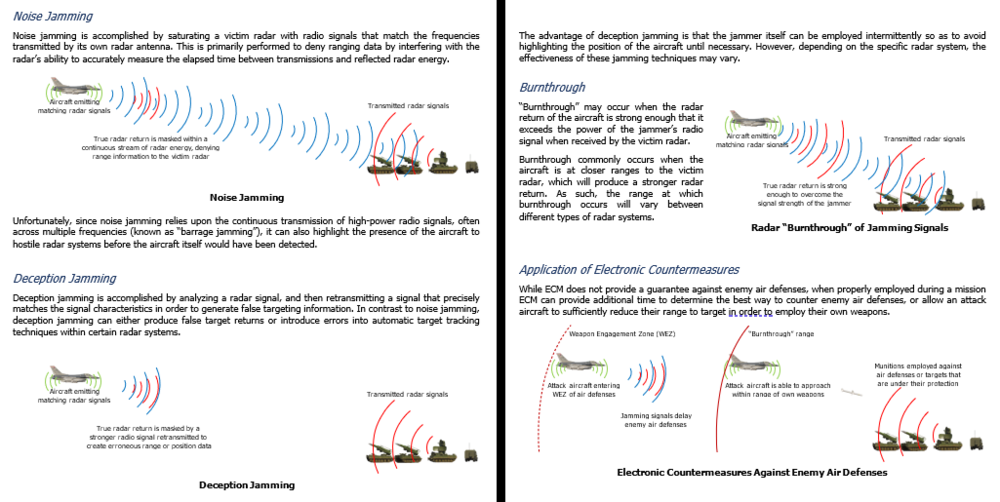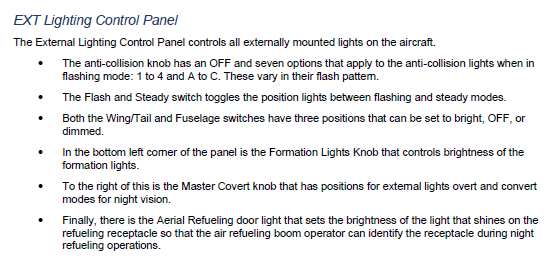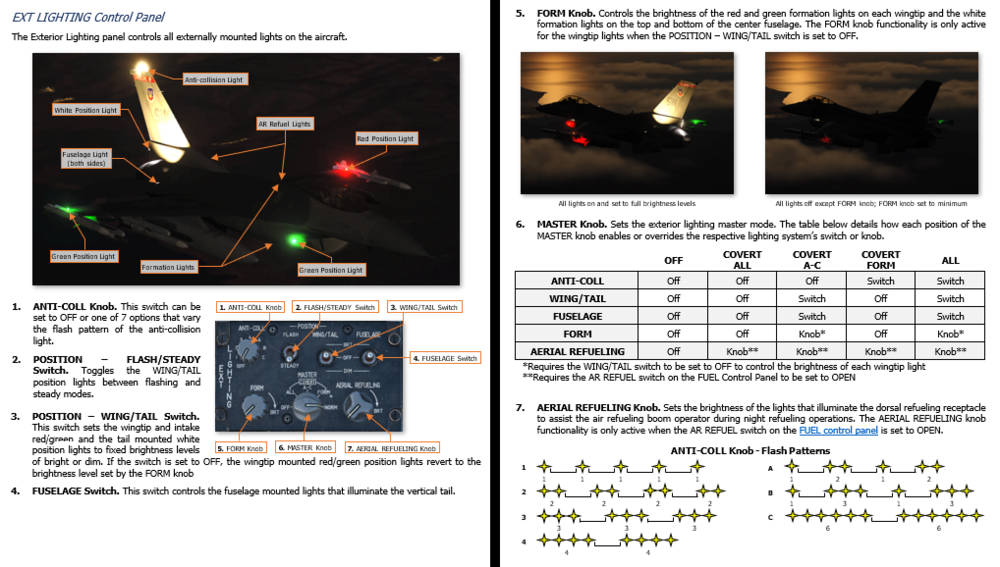-
Posts
2162 -
Joined
-
Last visited
-
Days Won
4
Content Type
Profiles
Forums
Events
Everything posted by Raptor9
-
Wags demonstrates it in this video. The manual is being updated to reflect it as well. I've also personally tested it myself.
-
This is not true. There is currently both noise and deception jamming present in the F-16 ECM pods. Choosing how and when you use such modes are predicated on the threats you are facing, the mission, and the flight profile at any given moment. Jammers are a tool that should be used when appropriate, and avoided when it is not. As such, the ECM pods are more effective against ground-based air defenses, and which mode you use and when you employ it will have varied results on what threat you are facing. I personally leave the jammer off when facing air-to-air threats. Because even in Radar priority mode, it still degrades the effectiveness of the FCR. I would much rather have full FCR effectiveness and get the opponent on the defensive as soon as possible with a long-range BVR shot. Indeed, leaving the jammer broadcasting continuously in noise jamming mode without a regard to the immediate tactical environment will highlight your position. As with most things, strategy is important.
-
Symbology Select Up Symbology Select Down Both are on the Cyclic stick
- 1 reply
-
- 1
-

-
Yeah, unfortunately, aside from the pilot having the option to switch off CUEING as AvroLanc mentioned (since the pilot doesn't have the option to disable SLAVE in the backseat), there really isn't any options to customize the IHADSS symbology elements aside from the four different symbology modes themselves.
-
Hello everyone, I'd like to provide an update regarding the F-16C manual's status. The F-16C manual has been under review and revision since the first week of August, with a lot of effort devoted to not only new sections for features that have come to the DCS: F-16C in the past year, but to improve the existing sections to the quality expected of DCS Manuals. As such, here is one such example of an improvement: Existing EXT Lighting Control Panel section Updated EXT Lighting Control Panel section Additionally, the intent is to not just explain how to operate a panel, but to explain (when appropriate) how these systems function within the simulated tactical environment of DCS World. Here is an excerpt from the new ECM section. Throughout this process, it has been necessary to review the existing text to: Identify any shortcomings of the existing manual content. Identify any inaccuracies of the existing manual with regards to the current functionality in game. Test the procedures and explanations within the new/revised manual content to ensure it reflects the current state of the DCS: F-16C. This manual revision is intended to be as thorough as possible; but at the same time, we recognize the need to push new and up-to-date information as soon as possible is an important aspect for the players. As such, the plan will be to release these updates in stages, so that completed chapters or sub-sections are released when able. Currently the plan is to release the following completed sections in the first edition of updates: Updated DCS: World Fundamentals and F-16C Weapons chapters. Updated Cockpit Overview chapter. This chapter alone has grown from 16 pages to 40. With thorough descriptions for every switch, button or analog gauge functionality. Updated Hands-On Controls (HOTAS) section to reflect new capabilities and logic. More thorough explanations of contextual HOTAS commands and logic will still be needed in each individual sensor or weapon chapter of course. Updated HUD and HUD Control Panel section. Updated and expanded Defensive Systems chapter to include additions for the ECM pods and more thorough and accurate explanation of the countermeasures logic with regard to the CMS commands on the control stick and the CMDS panel settings (The explanation of the CMDS Modes logic alone is now 1.5 pages to capture all the aspects of its logic, with the Defensive Systems chapter grown from 6 pages to 16). Updated and expanded Appendices to include updated ALIC codes, RWR abbreviations, HAS tables, and HAD threat classes, among others. Additional sections that are currently works-in-progress at varying states of completion, but are also intended to be released in the first edition of updates: New chapter covering the HARM Targeting System (HTS pod). Updated and expanded section explaining the ICP and various DED pages (this one in particular is quite the task). Updated section covering the basics of MFD operation, specifically the Horizontal Situation Display (HSD) MFD format. This final list is not all-encompassing of everything that is WIP, but rather the most crucial highlights that are being actively worked on for completion. After the first update edition is finalized, other sections such as the FCR, TGP, and various weapons will be undertaken as well. Ultimately, this is a labor of passion that will hopefully be worth the wait to all of you fellow virtual Viper pilots out there. Respectfully, Raptor
- 77 replies
-
- 39
-

-

-

w.i.p Flight Model (FM) since [21.09.2022] DCS 2.7.18.30348 Open Beta
Raptor9 replied to Dagobert666's topic in DCS: AH-64D
My point is that there is more going on under the hood than just the green SCAS indicators; and has been stated many times before, the flight model and FMC are works in progress. I wouldn't be taking any behavior of those little green indicators as certainty for how the FMC functions, because it isn't finished yet. -

w.i.p Flight Model (FM) since [21.09.2022] DCS 2.7.18.30348 Open Beta
Raptor9 replied to Dagobert666's topic in DCS: AH-64D
Correct. But let me ask you a question to clarify. Are you referring to stability of the aircraft in general or are you referring to yaw stability when at low speeds? The reason I ask is that Heading Hold is always present below 40 knots ground speed when the force trim isn't pressed, the pedals are within 3% of their force trim reference, and the yaw rate is less than 3 deg per second. So if that's that case, you may have been mistaking Heading Hold for yaw damping (which is also present but behaves within the overarching SAS logic). -

w.i.p Flight Model (FM) since [21.09.2022] DCS 2.7.18.30348 Open Beta
Raptor9 replied to Dagobert666's topic in DCS: AH-64D
Yes. It doesn't fully deactivate the SCAS, but it modifies the logic of it. The aircraft stability is virtually identical with the FTR held down versus not, the main difference is that you have additional "atmospheric upset damping" when it isn't pressed. The green SAS indicators on the Control Indicator aren't 100% gospel of the flight computer's logic. With the same control settings applied to the Huey, I don't find the Huey any easier to fly than the AH-64. It feels different and it needs to be flown differently because of how it responds to control inputs, and it normally takes me a few minutes to get myself out of my AH-64 flying mindset and into the UH-1's, but both helicopters require constant control adjustments to keep the aircraft flying how you want it to. Helicopters fly using a delicate balance of various opposing forces, and these forces are constantly changing magnitude. This requires inputs to maintain a balance against all these forces. The Ka-50's dampers behave slightly differently than the AH-64D's, and the Ka-50 is also several tons heavier. Different helicopters require different control inputs and have their own "feel". I'm not saying "git gud", but when it comes down to it, the AH-64D is actually easy to handle if you avoid trying to fly it like a UH-1 or a Ka-50. There are some similarities between them, but at the end of the day they are different helicopters. It's the same thing as the F-16 vs the F/A-18. They have similarities, but both fly different and were designed to dogfight differently. -

w.i.p Flight Model (FM) since [21.09.2022] DCS 2.7.18.30348 Open Beta
Raptor9 replied to Dagobert666's topic in DCS: AH-64D
I recommend re-evaluating any existing saturations or curves that people are using, to include their trim options in the special tab. As the behavior the flight model has evolved since release, any saturations/curves may be outdated given any changes. For my own set up, I have a Saitek X52 stick/throttle and Saitek rudder pedals, both of which are spring-centered. I use a 90% Saturation Y for Pitch, Roll and Yaw to make up for the fact my controls don't have the full movement length of the real aircraft's cyclic and pedals, and Instant Trim for both the Cyclic and the Pedals in the special tab. Also, I really recommend that the force trim should be utilized when moving the controls. It's a critical component of the flight controls. -

need track replay AI make heli keeping rotation
Raptor9 replied to _UnknownCheater_'s topic in Bugs and Problems
Without a track it is impossible to determine the cause of this from an 8 second video clip that just shows the aircraft spinning. The pedal input is full left, but there is no indication if the player has control and thinks the AI is flying, or if the AI truly is in control, if the tail rotor is shot off, etc. Please follow the proper bug reporting guidelines. -
Yes. Full-size, manned helicopters differ greatly compared to R/C models, in a lot more ways than I suspect you realize. The comparison of the two isn't even close, not even in the same ballpark. But if you think that teaching anyone to fly an R/C helicopter is anything like teaching someone to fly a real helicopter, you are quite mistaken. (And yes, I've flown RC helicopters as well) I fly with a Saitek X52 and Saitek rudder pedals, no expensive set up here. Additionally, I have been playing flight sim games for decades as well (as has @bradmick), so we are fully aware of the differences between real helicopters, professional simulators, and desktop flight sim games. Further, equating force trim to "automation" is a false premise. The AH-64D's force trim is not a crutch or "an easy way out", it is a key components of the pilot-machine interface of the AH-64D. This isn't a Huey, or an R/C helicopter, there is more to flying the AH-64D than wiggling the sticks. I've noticed a common thread as of late, in that several demographics of forum-goers: helicopter mechanics, crew chiefs, engineers, and in this case an R/C helicopter operator, all are of the opinion that they are more qualified to comment on the accuracy of the AH-64's flight model than those that have spent thousands of hours and years of their lives flying the real AH-64D (not every person in those demographics, just that at least one person from each has commented as such). I mean no disrespect to you or your own experiences (or the experiences of others that work on or with rotorcraft), but such assumptions are silly. In your very own words, "you can study helicopter theory for 20 years, when you finally get in the seat, you'll still be a novice like anyone else". If you truly believe this, lacking first-hand knowledge doing the very thing that the DCS: AH-64D is simulating, which is being a crewmember in an AH-64D, how can you possibly assess the accuracy of the experience or the relevance of its flight control systems better than someone that has actually flown the real AH-64D? Again, I mean no disrespect, you are entitled to your opinion. But as someone that has seen both sides of the coin, as a helicopter mechanic and a pilot, not to mention played all sorts of flight sim games in the past 30 years, I'm telling you that your assertions are off the mark in these regards.
- 21 replies
-
- 10
-

-
Like razo+r stated, you'll want to verify under the Options "Special" tab, in the Ka-50 category, that the Customized cockpit is set to English instead of Default. Also, in the "Gameplay" tab, you'll probably want to verify Avionics Language is set to English instead of Native as well. This will ensure additional items such as the ABRIS display are translated into English as well. There will still be some items in Russian however, like the HUD and Shkval, but those indications will be mostly limited to abbreviations and can be easily interpreted based on context.
-
The point is that force trim is a key component to learning how the AH-64 actually operates. You are equating all helicopters as the same; but they are not. If you teach someone to fly an AH-64 without the force trim and FMC, and then introduce the FMC and force trim back into the equation and expect them to re-learn their muscle memory, you are actually causing "negative learning". There is a reason that the US Army does not teach their pilots how to fly the AH-64 with the FMC off (I sincerely doubt other nations do so either, but since I haven't flown in other nation's flight schools of instruction, I will only comment on the US Army). It's called primacy. It means that if you learn something incorrectly the first time, it will take twice as long (or longer) to re-learn something the correct way later. Brad knows this quite well, he's not only been an instructor on the AH-64 for many years, he has thousands of hours in the aircraft. I can assure you as someone that has practiced autorotations in a real AH-64D as well as done full autos to the ground in training helicopters, the last thing you should be doing is spinning your helicopter around when you are trying to perform an autorotational decel and touchdown. I don't know where you are getting this information that doing a 180 degree spin at the bottom of an autorotation is somehow better, preferred or even makes sense. You are taking a potential emergency situation and adding complexity to the maneuver that is more likely going to lead to death of the crew. Incorrect. A helicopter like the AH-64 is controlled in pitch/roll using rotor disc tilting, which means the total lift vector of the main rotor system is tilted to create an offset from the aircraft center-of-gravity, causing a rotational motion around the center-of-gravity. This lift vector is proportional to how much lift, or thrust, is being produced by the main rotor. If the lift amount is small, the total amount of cyclic input required to achieve the same rotational force to induce a pitch/roll is higher. In an autorotation, the difference is that the collective is bottomed out and the rotors are at flat pitch. The rotors are indeed producing a little bit of lift due to the autorotational effect, but the amount of lift is obviously much smaller than in normal flight (which is why the aircraft is falling like the Space Shuttle). As a result, you will not have the same cyclic authority in an autorotation compared to straight and level flight.
-
Possibly. Whenever I am analyzing behavior from an aerodynamics aspect, I disengage all FMC channels to isolate the SCAS from any aerodynamic effects.
-
This was interesting to watch, however I do want to clarify a few items. 1) Respectfully, recommending to players that they do not use force trim in the DCS AH-64D is the opposite of what they should be doing. Depressing the Force Trim Release switch isn't simply a method for the pilot to make the flying easier, it's how the AH-64 pilot communicates to the Flight Management Computer the pilot's intent for maneuvering. 95% of the time in which I am moving the controls, I'm pressing the force trim and then releasing when I'm done moving them. The force trim in the AH-64D is not meant to be treated as an optional device that the pilot can decide not to use. I mean, they don't have to, but it interacts with many aspects of the FMC in which the behavior of the AH-64D is affected, and not using the FMC will undoubtedly cause more issues with expectations of behavior. 2) I am unsure what the meaning is that hovering in ground effect is not "experiencing a true hover". From a pilot's perspective in a 7-ton AH-64D, the only difference between an IGE hover and an OGE hover is that the OGE hover requires more engine power to maintain altitude from the increased induced flow through the rotor system. Personally, I find it easier to practice hovering close to the ground in DCS because you can detect the deviations of the helicopter's position when you are closer to the ground, and since small movements will be more apparent. The control touch required to hover a helicopter is just as difficult at 80 feet as it is at 5 feet, but in the simulator it can be more difficult detecting deviations when hovering at 80 feet since you are limited to visual feedback, due to the lack of detections of inertial movements from the inner ear and proprioceptive feedback. 3) While there are some needed improvements to the AH-64D's autorotational behavior, and these will undoubtedly occur as the flight model is refined, there seems to be a misunderstanding in how much inertia the AH-64's rotor system should have. Some helicopters like the UH-1 Huey have a "high inertia" rotor system in which the rotors have enough momentum to keep their RPMs from slowing when exposed to drag during an autorotational deceleration, allowing you to maintain a momentary hover at the bottom of an autorotation. However, the AH-64 has a "low inertia" rotor system in which the rotors can spool down quite rapidly at the bottom of an autorotational descent to landing when the collective is increased to decelerate and cushion the descent for touchdown. Attempting to hover at the bottom of an autorotation in a real AH-64 would be foolhardy, as it should be in DCS: AH-64D. Additionally, a turn at the bottom of an autorotation to perform a tail-up flare would be tantamount to an airshow stunt, or something only performed in DCS, so I just want to clarify that such an attempt in real-life wouldn't ever be intentionally attempted during an autorotation, as it would most likely result in death to the crew. I wasn't sure if that was intended as a DCS-only challenge, or as a comment about something that should easily be performed in real-life, but it's not a thing for the AH-64D. However, overall, thank you for the feedback. I hope you'll appreciate the continued improvements to the flight model that will occur throughout the Early Access process. Respectfully, Raptor
-
This has already been noted internally but it isn't a high priority.
-
Thread locked at OP's request.
-
The DCS: AH-64D is accurate for the version that existed on the real aircraft in that time period. BigNewy's comment is to avoid discussing sensitive capabilities that the DCS: AH-64D shouldn't even have in the first place. Anything beyond that is going down a rabbit hole that will not be entertained.
-

w.i.p IHADSS Boresighting - circles stay concentric. Bug ?
Raptor9 replied to Jel's topic in Bugs and Problems
In this post: I show an image of how the reticle should appear: As BigNewy stated, there are improvements coming. Namely, the "projection effect" within the BRU tube itself. The reticle itself is correct, however, in that it is displayed as a singular reticle image. -

What makes the Apache the most difficult helicopter module to fly?
Raptor9 replied to Schmidtfire's topic in DCS: AH-64D
The AH-64D was a paradox to me when I transitioned from flying smaller training helicopters. You needed to be more conscious of your inputs since the AH-64D was more responsive, even though the training helicopters were 1/5th the gross weight of the AH-64D. On the flip side, you quickly learned you needed to start your turn from base to final sooner in the AH-64D, otherwise the momentum of the 7 ton AH-64D would blast you right through the final approach course line. So it was quite the change going to an aircraft that was more maneuverable but simultaneously had a lot of momentum piled up behind the cockpit that you had to take into account. -

fixed internally Select ACQ TADS to operate? Help!
Raptor9 replied to ThorBrasil's topic in DCS: AH-64D
It's okay @AvroLanc, I understand your feelings. Believe me when I say that the DCS AH-64D dev team and I are on your side. It's just, on occasion you need to break a few eggs to make an omelet. The dev team tries to minimize the number of eggs that need cracked and try to get the omelet ready as quickly as they can before the breakfast party shows up, but sometimes the party members are hungry. -
There is an option in the mission editor to enable George to track air targets. This option is specific to individual aircraft, meaning one aircraft placed in the mission could have the AI CPG enabled to track air targets and another could have this disabled. If this is unchecked for a given player/client aircraft, George will ignore airborne targets. This may be the cause of the inconsistent behavior regarding hostile aircraft being processed by George.
-

fixed internally Select ACQ TADS to operate? Help!
Raptor9 replied to ThorBrasil's topic in DCS: AH-64D
It's already fixed internally. I'll stress that this is the nature of Early Access. Development of additional features and improvements will continue, and sometimes things like this are necessary to move the project forward. -
Nope. This is one of the challenges of close combat. It all comes down to situational awareness, crew coordination, and good communication to avoid fratricide. The "IFF functionality" of George (or Petrovich in the Mi-24) isn't like an IFF transponder in fighters that relies on technology, but it simulates the "situational awareness" of the AI crewmember. FYI, George and Petrovich are not fool-proof either. They can make mistakes like a real person.




